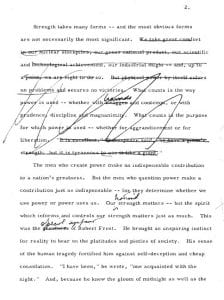FYW Assessment_Reflective Essay Prompt
Assignment Researched Essay English 185 Fall 2019
Here’s a clear and helpful guide on how to quote Shakespeare.
And here’s the same professor’s clear guide on quoting prose.
For October 10: Read your chosen academic article clearly and discern the author’s or authors’ purpose, their audience, the social situation that prompted their research, and their “exigence,” or what motivated the research (perhaps the “so what”). In about 500 words, address the above points. Quote from the article at least twice using MLA parenthetical citations. Also include a “Work Cited” reference, in which you correctly cite the article. Print your reflection and bring it to class on October 10.
take th cacao nuts which must be very godd
put aside all the brooken (to be done after) put them in a coper or
iron frieng pan neuer used for any pech ouer
a a good moderat fire & stir them continualy
Yt all may be alike tosted
to know wen thay are enough take some in your
hand if thay crumble easily thay are enough or if
thay crack & leape in the pan
the spices must be beaten fine & sevied & all but
the vanelles mixed with the suger iuste as the use
then
break the cacaos upon as stone
clener them from the husks
when it is in a mas like dooe grind it ouer againe
wth all the strength possible then strew in the suger &
spice mix it well to gether & grind it agane twice
ouer
lastly put in the vaneles mix’d wth sye the suger grinding
it till it looke like batter when it is cold you mak
make it in to what forme you pleas
the stone must stand ouer fire all the while it is
a grinding
it is not fitt to use till it has bene 3 munths made
Shakespeare King Lear 1974 Shakespeare in the Park from Gianni B on Vimeo.
Advantages of Longhand Over Laptop Note Taking copy
Why you should take notes by hand — not on a laptop – Vox copy
First drafts and perfectionism
Starting sentences with “but”:
There is a widespread belief—one with no historical or grammatical foundation—that it is an error to begin a sentence with a conjunction such as and, but or so. In fact, a substantial percentage (often as many as 10 percent) of the sentences in first-rate writing begin with conjunctions. It has been so for centuries, and even the most conservative grammarians have followed this practice. (Chicago Manual of Style)
“Many of us were taught that no sentence should begin with “but.” If that’s what you learned, unlearn it—there is no stronger word at the start. It announces total contrast with what has gone before, and the reader is primed for the change.”
“I can’t overestimate how much easier it is for readers to process a sentence if you start with ‘but’ when you’re shifting direction.” (William Zinsser, On Writing Well)
First person in academic writing: Duke University
First person in academic writing: UNC Chapel Hill
First person in academic writing: Chicago Manual of Style
First person in academic writing: Cancer Journal for Clinicians
Unnecessary phrase: The opinion of the manager
Correction: The manager’s opinion
Unnecessary phrase: The obvious effect of such a range of reference is to assure the audience of the author’s range of learning and intellect.
Correction: The wide-ranging references in this talk assure the audience that the author is intelligent and well-read.
Unnecessary phrase: It is a matter of the gravest possible importance to the health of anyone with a history of a problem with disease of the heart that he or she should avoid the sort of foods with a high percentage of saturated fats.
Correction: Anyone with a history of heart disease should avoid saturated fats.
(U Wisconsin-Madison)

Thomas Lux (1946-2017) from Neil Astley on Vimeo.
The thing gets made, gets built, and you’re the slave
who rolls the log beneath the block, then another,
then pushes the block, then pulls a log
from the rear back to the front
again and then again it goes beneath the block,
and so on. It’s how a thing gets made – not
because you’re sensitive, or you get genetic-lucky,
or God says: Here’s a nice family,
seven children, let’s see: this one in charge
of the village dunghill, these two die of buboes, this one
Kierkegaard, this one a drooling
nincompoop, this one clerk, this one cooper.
You need to love the thing you do – birdhouse building,
painting tulips exclusively, whatever – and then
you do it
so consciously driven
by your unconscious
that the thing becomes a wedge
that splits a stone and between the halves
the wedge then grows, i.e., the thing
is solid but with a soul,
a life of its own. Inspiration, the donnée,
the gift, the bolt of fire
down the arm that makes the art?
Grow up! Give me, please, a break!
You make the thing because you love the thing
and you love the thing because someone else loved it
enough to make you love it.
And with that your heart like a tent peg pounded
toward the earth’s core.
And with that your heart on a beam burns
through the ionosphere.
And with that you go to work.
–Thomas Lux